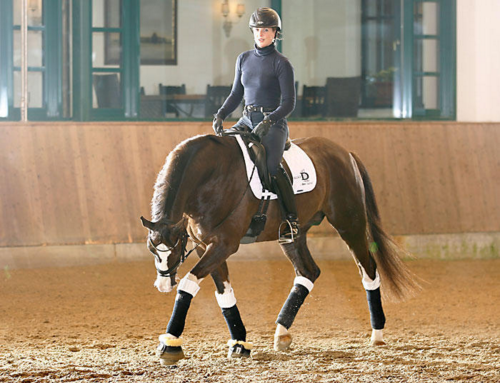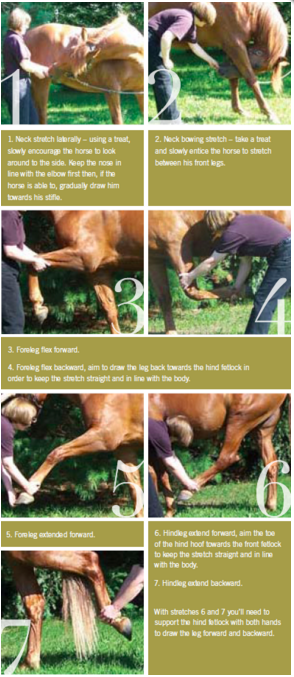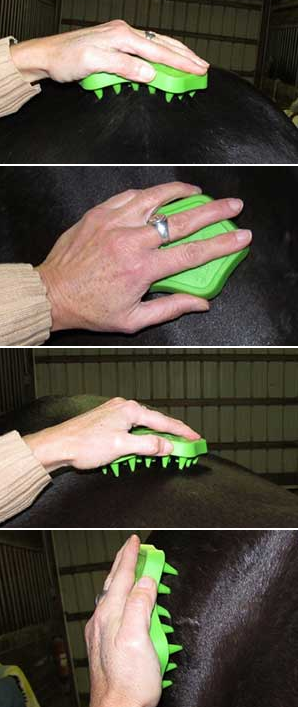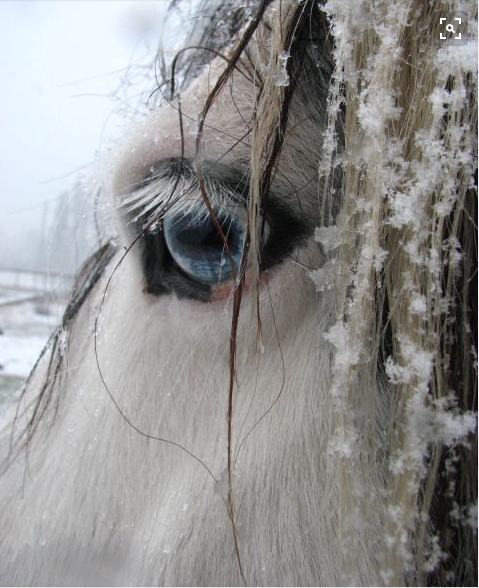Wintry weather, hectic schedules and lack of stretching can make anyone stiff- especially your horse. An inability to bend to the right might not be due to the fact that your horse simply isn’t in the mood that day. If you take a moment to look beyond the surface, you might find that your horse isn’t unwilling to respond–he’s unable to respond. He simply can’t do what you’re asking because of stiffness.

Stiffness is defined as the inability or unwillingness to bend or flex as a result of an inability to stretch the tissues needed for bending to occur–in short, a reduced range of motion in the back, neck, or leg joints. But stiffness isn’t actually a disorder in itself. Rather, it’s a symptom of–and reaction to–pain or discomfort that could stem from nearly anything, including arthritis, vertebral injury, bad teeth, poor saddle fit, sore muscles, and more. This probably explains why stiffness is such a prevalent problem. It
affects horses of all breeds, ages, and genders, and it crosses all lines of discipline, afflicting high-end performance horses as readily as childrens’ pleasure mounts.
In fact, Kevin Haussler, DVM, PhD, DC, of Cornell University’s Integrative Medicine Service with the Large Animal Clinic, notes that “80-90% of the horses we see in here present with stiffness, not obvious pain or lameness.”
The bad news is that it’s hard for veterinarians to measure and accurately evaluate stiffness. So, diagnosing its presence and cause becomes primarily a process of elimination. The good news is that horse owners have many treatment options at their disposal to combat stiffness once the underlying problem is diagnosed.
In this article, we’ve compiled a collection of the most commonly used weapons in the war on stiffness, noting which ones work the best on specific causes.
Pre-Ride Grooming and Warm-Ups
As with human athletes, a good stretch and warm-up for your horse will loosen and literally warm your horse’s muscles before your “real” riding begins. Loosening the muscles while grooming is a great habit to get into. With a Posture Prep Cross Fiber Groomer you can help your horse get loose while cleaning off excess dirt- because who has time to do both? Pre- ride massage and warm-up can especially benefit arthritic horses and horses which are sore from the previous day’s exercise. Warm-ups also help prevent muscle soreness and soft tissue injuries.
Jessica Jahiel, PhD, a clinician and author specializing in holistic horsemanship, recommends 15-20 minutes of walking followed by five to 10 minutes of trotting on a long rein before asking your horse for any real effort. She also suggests allowing the horse to stretch his head and neck out every few minutes during the ride.
“After your workout, be sure that your cool down–or ‘warm-down’ as I prefer to call it–is equally thorough,” she adds. “Give your horse another chance to trot on a long rein, then walk him until he is cool and dry.”
Jahiel also encourages riders to alternate days of intense schooling with light-work days, such as trail rides. (Haussler notes that this is often referred to as cross-training.)
“Muscles have to be given time to recover and rebuild after workouts,” she explains. “Use your good sense and treat your horse the way you would treat yourself if you started on a body-building program at the gym.”
Stretches
Much like a pre-ride warm-up, stretches benefit any horse by loosening muscles and connective tissue before a workout. They can be particularly useful for horses which spend most of their time in stalls with little to no turnout time.
“Horses are meant to be outside, lowering their heads to graze, raising their heads to look around, and moving about,” says Haussler. “If the horse is stuck in a stall for extended periods of time, you have to create artificial ways to get that flexibility back.”
Some stretches can also act as diagnostic tools to help determine if your horse needs chiropractic work, he says.
Haussler recommends doing stretches with your horse before and after riding; he also notes that some stretches can be performed while you’re mounted. In addition, he encourages horse owners to consult with a trained and qualified equine chiropractor, physical therapist, or massage therapist to determine which stretches will benefit your horse the most.
“They can also advise you on how many repetitions to do and how aggressive to be with the stretching,” he says.
Massage
Few people object to a good massage, and horses seem to feel the same way. Like stretches and warm-ups, this tried-and-true muscle relaxer helps your horse get limber while easing pain and releasing tension.
As mentioned above, utilizing a Posture Prep Cross Fiber Groomer makes a nice do-it-yourself massage and groomer- pre and post workout.
Horses with musculoskeletal problems might require a session with a qualified equine massage therapist. Joyce Harman, DVM, MRCVS, of the Harmany Equine Clinic in Washington, Va., recommends looking for

PC: Equine Wellness
someone who has completed courses in both human and equine massage therapy, or who has completed an extensive equine massage therapy program.

Grooming and Massaging with the Posture Prep Cross Fiber Groomer
“You don’t want someone with only one week of training,” she cautions. “It’s difficult to learn good-quality massage therapy in a week.”
Chiropractic Work
Horses with asymmetries of the body (i.e., the pelvis is higher on one side than the other), trauma to the vertebrae, or arthritis can all benefit from chiropractic adjustment, says Haussler. During a chiropractic session, the practitioner will move the horse’s joints to affect muscle relaxation, thus restoring motion to the neck, back, and/or limbs, says Haussler, who is a Doctor of Chiropractic.
Beware of inexperienced or poorly trained chiropractors–they can harm your horse, warns Harman. She recommends using someone who is certified (as she is and as Dr. Pat Bona is) by a reputable professional organization such as the American Veterinary Chiropractic Association. “Make sure the person is willing to answer all your questions,” says Harman. “If possible, go watch them work–most good chiropractors will let you.”
Horses typically need at least four treatments to recover or get on the road to recovery, says Harman. Per-session prices range from $50 to $150, and you should expect to get what you pay for. “There are charlatans who will charge you $150 for 10 minutes,” acknowledges Harman. “But usually, if they’re charging that much, the person will spend a lot of time with the horse and will work in more than one modality, such as chiropractic, stretching, muscle work, and acupuncture.”
Acupuncture
However, says Harman, “Even these horses will get some improved motion of the spine, because you’re relaxing those tight soft tissues.”
Harman again emphasizes the value of using a qualified practitioner. The American Academy of Veterinary Acupuncture (AAVA) has a directory of active members (including Harman), who must be graduates of a veterinary school and must meet AAVA-approved course requirements, including ongoing study.
Harman notes that in many areas, horse owners have access to either a good acupuncturist or a good chiropractor–but not both. That’s okay, she says, because “for many problems, either one will get you a long way. It’s more important to get a good-quality practitioner than to worry about which type is most appropriate.”
You Can Win the War
The bottom line, says Harman, is that “stiffness should be correctable.”
In many cases, you can completely cure the horse of the underlying ailment that causes his stiffness. And even in cases where the horse suffers from a chronic condition such as arthritis, your careful, consistent efforts to battle stiffness can improve his performance and, more important, his quality of life and his pleasure of performing with you.
By: Sushil Dulai Wenholz (of TheHorse.com) & Jordan Manfredi

